

Updated January 2, 2025
The cost of building a mobile app with a development company varies according to the app’s features, complexity, and the type of firm employed. Clutch surveyed 102 app development companies to determine the cost of building a mobile app.
Android’s app store, Google Play, had nearly 3 million apps in March 2017, while Apple’s App Store had 2.2 million. These numbers continue to grow, showing that more businesses are investing in apps to engage their customers.
If you choose to work with an app development company to build an app, the process can seem overwhelming. You may have questions like: How does the process work? How much will it cost?
Looking for a Mobile App Development agency?
Compare our list of top Mobile App Development companies near you
Using data collected from 102 app development companies from around the world to update our 2015 survey, we explain the different stages of the app development process and the approximate cost of working with an app development company to build an app.
Use this article to determine how much time and money building an app with an app development firm costs.
There are five core steps in the app development process:
We explain these steps, potential costs, and what your business needs to do throughout each.
Average costs are based on our survey, which asked app development firms to estimate the cost of each stage for one project that was completed in the past year.
The pre-research or “discovery” stage clarifies all elements of an app development project, ensuring that the app development company and its clients are on the same page before building a mobile app.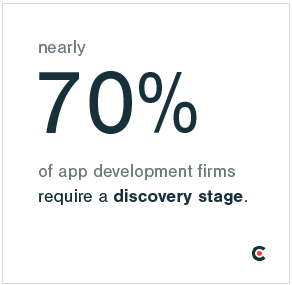
The discovery stage reflects a change in the overall app development process. In the early days, businesses’ appetite for apps led them to invest in app development without a clear idea of the app’s value.
Now, businesses consider whether they truly need an app.
“The early days of app development were more about what we could do than what we should do. These days brands and startups need to be far more strategic. Where will their app be able to create value in the lives of their target users? How will they be able to measure and demonstrate that value?'” said Drew Johnson, Co-CEO of App Partner, a mobile app design and development agency.
Answering these questions is vital to your app's success. A 2014 study by Gartner found that developers consider less than 0.01% of consumer mobile apps financial successes.
Nearly 70% of app development agencies surveyed require a discovery stage before moving forward with a project.
For a little over half of the firms surveyed, the discovery stage costs less than $5,000.
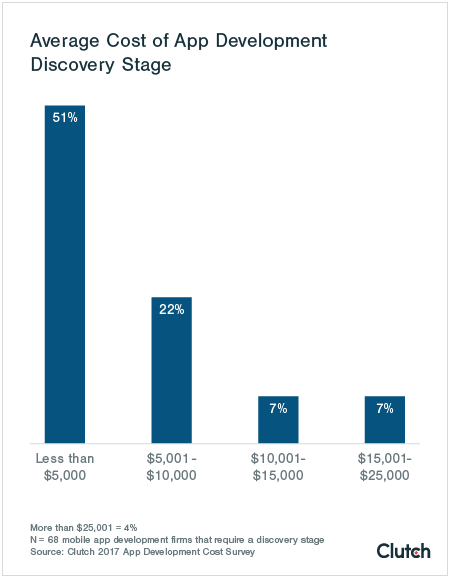
The discovery stage is different for every app development company, but they use it to determine the specifics of the project before beginning development.
During the discovery stage, app development companies may:
The length of the discovery stage varies: “It could be something that takes two weeks or two months,” said Jeremiah Jacks, Founder of Digital Brand Group, a custom software development company. For case studies about how three app development firms approach the discovery stage, read "Inside the App Discovery Stage."
At the end of the discovery stage, an app development firm provides a price quote for the project. Pricing falls into two different structures:
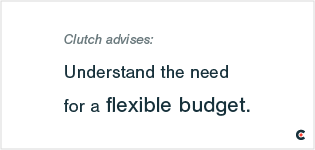
A fixed bid is a set price and a set timeline. This pricing structure works well for smaller projects or projects with a clearly defined scope.
Larger projects have unpredictable, moving parts and a less defined scope. For a fixed bid, if the project’s scope changes, you can either increase the project’s budget or keep the same time and budget and receive a lower-quality app.
A time and materials pricing structure is determined by the time and materials needed for a project and typically is an hourly rate. This pricing structure works well for large projects with more ambiguous scopes.
However, with a time and materials pricing structure, not knowing a set, final cost upfront, worries some businesses.
With both a fixed bid and a price range, understanding the need for flexibility with your budget is key to reducing anxiety.
If your project is smaller, be aware of minimum project sizes when choosing an app development firm. Some app development companies require a minimum project size to move forward with a project.
Nearly 30% of app development firms surveyed always require a minimum project size, while 60% require one depending on the client.
The average minimum project size is $5,000 - $10,000. However, the typical cost to build a meaningful app will likely be significantly more than $5,000 - $10,000.
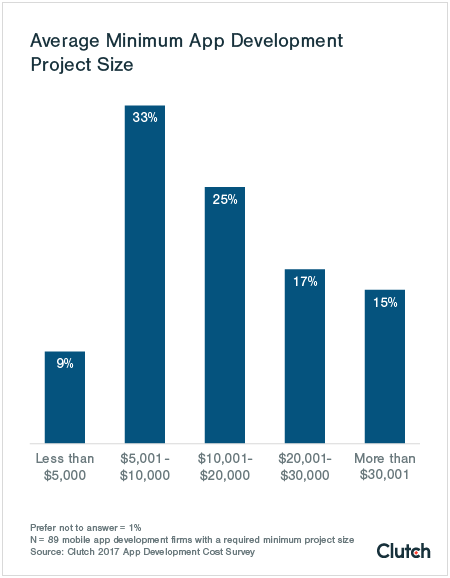
Minimum project sizes ensure the relationship between a client and app development firm is valuable to both parties.
“We have a minimum project size because we believe apps need to solve business problems effectively and maintain quality standards to engage users better,” said Nik Sanghvi, Head of U.S. Sales and Business Development at Robosoft, a mobile app development company.
Be sure to ask a company about minimum project size requirements before moving forward with a smaller project.
Once the app is clearly defined and planned out, app development companies can begin designing and developing it.
Before coding an app, it’s critical to understand how the app will look and work for a consumer through wireframing, visual design, and user experience (UX) design.
While the average surveyed cost of the design stage is less than $5,000, the cost depends on how many screens your app has. Screens are similar to pages on a website, and each screen requires its own design.
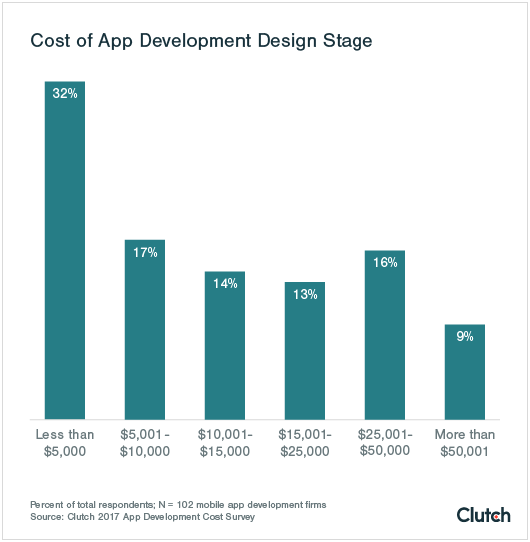
The average number of screens for the surveyed firms’ projects is 11-20.
If your app has many complex screens, prepare to pay more for the design stage.
Whether your app is hybrid or native influences the app’s final cost.
First, what is a hybrid or a native app?
Developers create native apps for a specific operating system – likely Android or iOS. If you want to target both platforms, you need to build two (or more) separate apps. Multiple apps and intricate coding mean native apps cost more than hybrid apps.
A hybrid app is a web app wrapped in a native framework and built using front-end languages such as HTML and JavaScript. Hybrid apps work on multiple operating systems but do not have the same level of functionality and load more slowly.
The majority of app development firms surveyed build native apps.
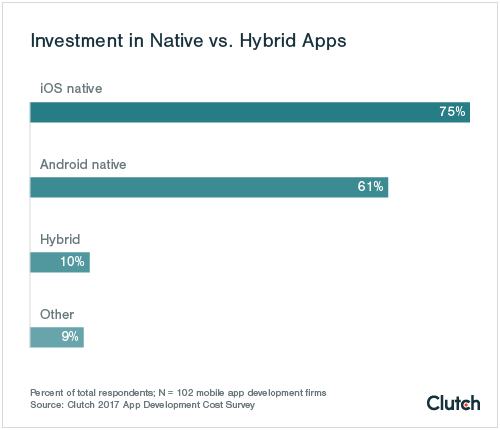
Understanding the benefits and drawbacks of hybrid apps versus native apps is important to discuss with your firm to understand potential costs.
The number, type, and complexity of the features in your app impact the final cost.
Our survey asked firms to estimate the cost of certain features, including push notifications, social engagement, a web portal for managing the app, and integration with native features.
Simple features, such as push notifications, user ratings and reviews, and user login, tend to be cheaper. More complex features, such as payment systems, web portals, and integration with native features, increase your project’s final cost.
For example, 70% of firms said that push notifications cost less than $5,000, while only 2% said push notifications cost more than $25,000.
Building a web portal to manage an app is a costlier feature since it requires back-end integration and complex coding. Only 29% said the feature cost less than $5,000, while the majority (53%) said it cost between $5,000 - $25,000.
Nearly 20% of app development firms said a web portal cost more than $25,001 to build.
| Cost of App Features | Push Notifications | Ratings & Reviews | Native Integration | Web Portal | Performance Management |
| Less than $5,000 | 70% | 71% | 40% | 29% | 61% |
| $5,001-$10,000 | 15% | 12% | 28% | 26% | 18% |
| $10,001-$15,000 | 7% | 12% | 11% | 16% | 5% |
| $15,001-$25,000 | 6% | 5% | 10% | 11% | 13% |
| $25,001-$50,000 | 0% | 0% | 7% | 6% | 1% |
| $50,001-$100,000 | 1% | 0% | 1% | 9% | 0% |
| More than $100,001 | 0% | 0% | 3% | 3% | 0% |
However, app development firms emphasize that any intricate features can increase the cost of an app. For example, though an outlier, one firm reported that push notifications cost a business between $50,000 - $100,000.
Dmitry Dobritskiy, CEO and Co-Founder of mobile app development company MindStudios, discussed how push notifications can increase a project’s cost.
“Take Facebook as an example,” he said. “They have a bunch of push notifications, and by clicking on every push notification, you are transferred to a particular place. The more complex logic you have [with a feature], the more expensive the development will be.”
Ultimately, you cannot assign features a set price and expect the price to be the same across every project.

“Every project is different. The underlying process and layers of complexity required to deliver each particular feature will determine the cost just as much as the total number of features,” explained Johnson of App Partner.
Engage with an app development firm to understand how much each feature may cost.
After building your app, test it to determine if it's ready to be launched.
Most app development firms (32%) said app testing and deployment cost less than $5,000. In a close second, 31% said it cost between $5,000 - $10,000.
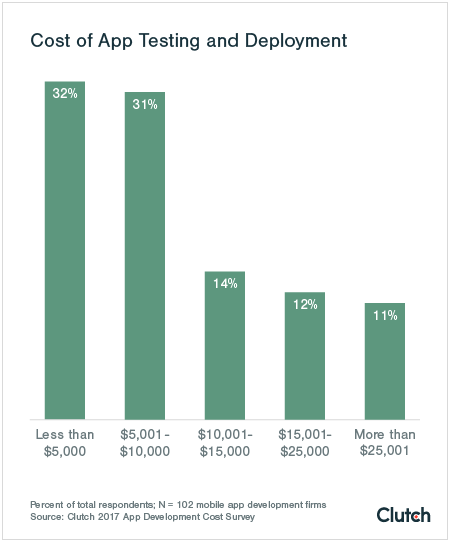
Thorough testing is critical to the quality of a product.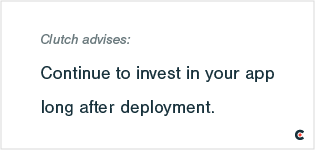
“It is increasingly important for an app to be well-designed and executed to stand out in app stores,” said Sanghvi of Robosoft. “Users want an app to function in a certain way, not to have any glitches or too much lag.”
An in-depth testing stage ensures app users face minimal issues such as glitches or lags.
Apps need maintenance and regular updates to function on the latest operating systems.
For a year after launching an app, 28% of app development firms predict that post-launch maintenance will cost less than $5,000, while another 28% predict it will cost $5,001 - $10,000.
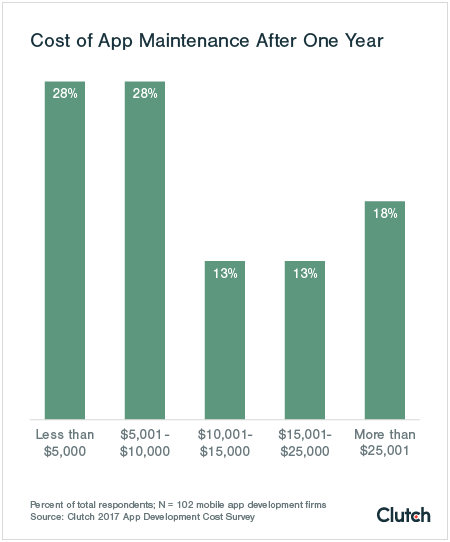
Dominic Tancredi, CEO of end-to-end product development agency Dom & Tom, spoke of the importance of post-launch maintenance: “You should be reinvesting, maintaining, and optimizing your product, which, ultimately, means your users.”
For Dom & Tom, maintenance is approximately 50% of the product’s initial price in the first year, 25% in the second year, and between 15-25% for every year after.
A business should understand that engaging an app development firm may be a years-long relationship if the firm continues to maintain the app.
Marketing is vital to the success of an app and sometimes an overlooked cost. You deployed your app. Now, how do you actually get customers to use it?
“I’ve seen a lot of startups develop mobile apps to break into the MVP [minimum viable product] stage. Then, they suddenly realize that they are out of money, and they can’t start marketing activities before their budget is consumed,” said Pawel Josiek, Co-Owner and Vice President of Future Mind, a full-stack software development company.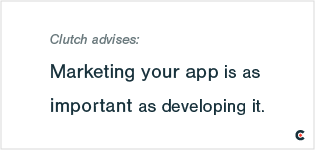
Not having the budget to market an app is challenging for both businesses and developers.
“From our developers’ perspectives, it’s sad when months of their hard work and commitment just go to the trash,” continued Josiek.
Dmitry of MindStudios experienced similar scenarios. Even the best apps need money to attract users.
“People think they can create some kind of project and then that’s it,” Dmitry said. “They use all the budget and resources to build something. But in the end, it’s just another ghost because there is a great project without any users.”
Some app development companies will offer assistance with marketing, and some marketing agencies specifically focus on apps.
For more information on marketing strategies, read Clutch's accompanying article, "How to Make an App."
Communication is vital when working with an app development firm, but specifying a communication strategy from the start is especially important when working with firms outside the United States.
Depending on the project, either a local or offshore firm can be an excellent fit for a U.S.-based business. However, businesses sometimes look abroad for a cheaper cost.
Improvements in communication tools have made collaboration across oceans easier.
Elisa Amarelle, Co-Founder of Bixlabs, an app development firm in Uruguay, described her company’s process for communication.
“To communicate and organize the process, we use JIRA, Slack, and GitHub,” said Amarelle. “We use Slack to communicate daily with the client or with the whole team. We upload all the code to GitHub for reviews, and we track all the tasks in JIRA.”
For some businesses, these communication tools enable a fruitful and collaborative working relationship. However, other businesses may still struggle with time zone differences when working with an offshore partner.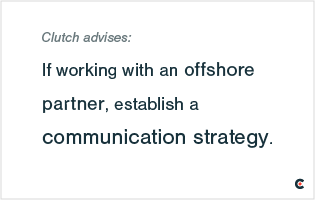
For example, an Indian development team may not be available for the latter half of the U.S. workday, as the workday already ended in India.
Some businesses easily manage the time zone scenario, especially considering the cost savings they receive by choosing an offshore partner. For other businesses, the time zone difference is a dealbreaker.
Robosoft offers a hybrid model that blends both offshore savings and local communication. Businesses choose to use offshore developers and an onshore design and strategy team.
Robosoft typically recommends the onshore design and strategy team if the business is new to working with offshore firms.
“If the client hasn’t worked with offshore firms previously, then we recommend they use our onshore design and strategy team,” said Sanghvi. “That team, in turn, interacts with our offshore team based in India. It’s much easier for the client.”
Overall, the choice between offshore and onshore depends on your business’s flexibility and needs. No matter which option you choose, be sure to establish a clear strategy for communication from the very beginning.
App development experts emphasize two common misconceptions about the cost of app development.
Some businesses approach app development firms wanting the “Uber” for their industry, but it's important to keep expectations realistic. You do not need to create the “Uber” for your industry to be successful, and if you insist on creating Uber, be prepared for a steep investment.
Based on Uber’s success, it’s easy to see why businesses want to replicate it.
Uber capitalized on the ridesharing market, revolutionizing transportation, creating a new method of exchanging goods and services (the “sharing economy”), and nearly decimating the once-powerful taxi industry.
Yet, the Uber app took many years and millions of dollars to build to its current state.
Several app development experts share stories about clients who expected an app as intricate as Uber’s but did not understand the investment required.
“Uber’s invested millions into their product over the years,” said Johnson of App Partner. “We can’t price Uber out for you.”
Likely, that effort is unnecessary anyway. “You don’t need everything Uber does on the first day your app launches,” advised Johnson.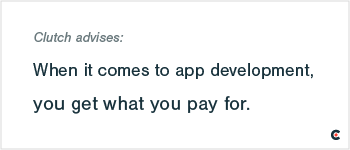
Ultimately, when it comes to app development, you get what you pay for.
“Many businesses walk in thinking that an app can be built for $25,000 - $50,000,” said Sanghvi of Robosoft. “There are very simple, trivial apps that can be built for that range. But, more often, for a typical e-commerce company or a media and entertainment company, the apps are not going to be simple, trivial, or stand-alone. Every brand should want to have a solution that is distinct from the competition and consistent with their branding.”
Businesses may be surprised at the typical price range for a high-quality app.
“What we recommend is that for any type of meaningful app, you should budget between $200,000 to $500,000 from end-to-end to be successful. That range would help you factor in the strategy, design, development and QA, not only of the mobile front-end, but also the middleware and back-end,” Sanghvi said.
Substantial apps – not just Uber – require significant time and expertise to build. Keep your expectations realistic and understand the pay scale that professional app development operates on.
Just like in grade school, the best way to prepare for an app development project is to do your homework.
Read up on the process. Analyze case studies. Watch videos. Speak with experts. The app development process is complex and potentially confusing. You are more likely to maximize your investment with an app development firm if you are knowledgeable.
Once you make the decision to go with an app development company over other development options, speak with several teams, advises Johnson of App Partner.
“Get a feel for how they define themselves and ask the harder questions: What are some recent examples in your portfolio you think are most relevant to my project?”, said Johnson. Then, Johnson recommends actually using the apps and reading their reviews on the App Store
It’s helpful to speak with a potential company’s former clients, ideally ones who had a similar budget to yours.
“Ask about how much more a client ends up spending between the original quote and when the app gets to the App Store,” said Johnson.
While this research may take time, it’s worthwhile to ensure you make the correct choice.
Once you pick a firm, it’s unwise to simply hand the project off and expect it to meet your goals.
“You need to be involved,” said Amarelle of Bixlabs. “You have the vision and the idea, so it’s important to be there to discuss and receive suggestions.”
Frequent collaboration is key to successfully developing an app with a firm.
App development cost varies considerably based on the number and complexity of features, whether the firm employed is onshore or offshore, and whether your app is hybrid or native.
Clutch surveyed 102 app development firms to understand how much your business needs to invest in an app, and how you can prepare for the cost.
First, to determine cost and streamline the app development process, conduct thorough research. A business and an app development company should plan out the app’s goals, designs, and schedule before development begins, as well as understand how the business and firm will carry the app from ideation to development, marketing, and maintenance.
Second, businesses should openly discuss needs, hesitations, and suggestions with their app development partner. A good app development firm will do the same in turn.
Third, a business should be flexible, since app development is intricate and multifaceted. There likely will be challenges, but these bumps will work out with collaboration and a willingness to change.
Working with a professional app development firm can be rewarding, if your business is knowledgeable, communicative, and flexible.


